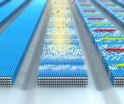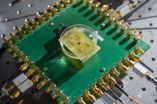(Press-News.org) Researchers at the Helmholtz-Zentrum Dresden-Rossendorf (HZDR) have tested a new approach to fabricating spin valves. Using ion beams, the researchers have succeeded in structuring an iron aluminium alloy in such a way as to subdivide the material into individually magnetizable regions at the nanometer scale. The prepared alloy is thus able to function as a spin valve, which is of great interest as a candidate component for use in spintronics. Not only does this technology use electron charge for purposes of information storage and processing, it also draws on its inherent magnetic properties (that is, its spin). Spintronics holds great potential for magnetic storage media. For example, with magnetic random access memories a computer's time-consuming start-up phase may cease to be an issue – as in that case it would be operational as soon as it is switched on.
Typically, a spin valve is made up of successive non-magnetic and ferromagnetic layers. This layering is a very involved process and getting these components to connect reliably presents a major challenge. This is why HZDR researcher Dr. Rantej Bali and his colleagues are taking an entirely different approach. "We've built structures with lateral spin valve geometry where the different magnetic regions are organized one next to the other as opposed to in layers one on top of the other," explains Bali. The idea behind this new geometry is to facilitate working in parallel on larger surfaces while keeping fabrication costs low.
First, the scientists annealed a thin layer of an iron aluminum alloy (Fe60Al40) at 500 degrees C. This resulted in formation of a highly ordered structure, where every other atomic layer was made up exclusively of iron atoms. According to the researchers' expectations, this substance behaved as a paramagnetic material – in other words, the magnetic moments became disordered. After this, the scientists coated the alloy with a protective polymer resist so that a striped pattern was produced on its surface. The resist-free regions were alternatingly 2 and 0.5 micrometers wide, and crucially, were separated from each other by 40 nanometer wide strips of resist.
Next, the material was irradiated with neon ions at the HZDR's Ion Beam Center – with important consequences. The scientists were able to demonstrate that the irradiated material exhibits very interesting properties. Beneath the protective resist strips, the material remains paramagnetic while the resist-free narrow and wide stripes actually become ferromagnetic. "A spin valve is switched via the magnetic field. Changing the spins' alignment – parallel or antiparallel – changes the electrical resistance. We're interested in the magnitude of the effect," says Bali. An externally applied magnetic field aligns the spins within these regions. Depending on the magnetic field's strength, they can be adjusted to run in parallel or antiparallel. This magnetization is permanent and is not lost if the outer field is switched off.
The reason for this behavior lies in the fact that the ion beam changes the alloy's structure. "The ions destroy the iron layers' highly ordered structure. They knock the atoms out of position and other atoms take their place, and, as a result, the iron and aluminum atoms become randomly distributed," explains Sebastian Wintz, a Ph.D. student who was part of the team of researchers. A small dose of ions is enough to play this atomic-level game of tag. Wintz characterizes the process as follows: "It's a cascade, really. A single ion is capable of displacing up to 100 atoms." The regions beneath the polymer resist stripes, on the other hand, are impenetrable to the ions – which is why these regions remain paramagnetic and separate out the ferromagnetic stripes.
Collaboration with the Helmholtz Center Berlin
Working closely with researchers at the Helmholtz Center Berlin (HZB), the HZDR scientists were able to visualize the material's magnetic structure using the special SPEEM (spin-resolved photoemission microscope) at the HZB's BESSY II synchrotron. The microscopic images showed the existence of regions with paramagnetic and ferromagnetic order demonstrating the high level of spatial resolution that can be realized by the structuring process using ion beams.
Additional experiments will allow Rantej Bali and his colleagues to investigate the properties of these magnetically structured materials. The researchers are also trying to figure out the limits to miniaturization of magnetic nanostructures.
INFORMATION: END
Ion beams pave way to new kinds of valves for use in spintronics
2014-02-18
ELSE PRESS RELEASES FROM THIS DATE:
Study uncovers surprising differences in brain activity of alcohol-dependent women
2014-02-18
BLOOMINGTON -- A new Indiana University study that examines the brain activity of alcohol-dependent women compared to women who were not addicted found stark and surprising differences, leading to intriguing questions about brain network functions of addicted women as they make risky decisions about when and what to drink.
The study used functional magnetic resonance imaging, or fMRI, to study differences between patterns of brain network activation in the two groups of women. The findings indicate that the anterior insular region of the brain may be implicated in the ...
85 percent of heart attacks after surgery go undetected due to lack of symptoms
2014-02-18
Without administering a simple blood test in the first few days after surgery, 85 percent of the heart attacks or injuries patients suffer could be missed, according to a study in the March issue of Anesthesiology. Globally, more than 8 million adults have heart attacks or injuries after surgery every year, and 10 percent of those patients die within 30 days.
The study suggests a new diagnosis, Myocardial Injury after Noncardiac Surgery (MINS), would be useful to physicians because of its broader definition from what is traditionally used to diagnose heart attacks now. ...
Chance of falling after knee replacement not increased by regional anesthesia
2014-02-18
Two types of regional anesthesia do not make patients more prone to falls in the first days after having knee replacement surgery as some have previously suggested, according to a study based on nearly 200,000 patient records in the March issue of Anesthesiology.
Regional forms of anesthesia – spinal or epidural (neuraxial) anesthesia and peripheral nerve blocks (PNB) – which only numb the area of the body that requires surgery, provide better pain control and faster rehabilitation and fewer complications than general anesthesia, research shows. But some surgeons avoid ...
Obese patients who feel judged by doctors are less likely to shed pounds, study shows
2014-02-18
Overweight and obese people who feel their physicians are judgmental of their size are more likely to try to shed pounds but are less likely to succeed, according to results of a study by Johns Hopkins researchers.
The findings, reported online last week in the journal Preventive Medicine, suggest that primary care doctors should lose the negative attitudes their patients can sense if the goal is to get patients with obesity to lose 10 percent or more of their body weight — an amount typically large enough to reduce blood pressure, cholesterol and diabetes risk.
"Negative ...
Medicaid's 'tube-tying' polices create roadblocks for low-income women
2014-02-18
PRINCETON, N.J.—Tubal ligation – commonly referred to as having one's "tubes tied" – is widely used to prevent unintended pregnancies. However, current Medicaid policies create roadblocks for low-income women trying to obtain the procedure, according to a review written by researchers at Princeton University's Woodrow Wilson School and other U.S. institutions.
Under a Medicaid rule enacted in 1978, women must currently wait 30 days after signing a written consent form to obtain a tubal ligation. This requirement is prohibitive for many women who want to receive the ...
Can marijuana protect the immune system against HIV and slow disease progression?
2014-02-18
New Rochelle, NY, February 18, 2014—New evidence that chronic intake of THC, the primary psychoactive ingredient in marijuana, can protect critical immune tissue in the gut from the damaging effects of HIV infection is reported in AIDS Research and Human Retroviruses, a peer-reviewed journal from Mary Ann Liebert, Inc., publishers. The article is available free on the AIDS Research and Human Retroviruses website at http://www.liebertpub.com/aid.
Patricia Molina and coauthors from Louisiana State University Health Sciences Center, New Orleans, report that chronic THC administration ...
Solar-induced hybrid fuel cell produces electricity directly from biomass
2014-02-18
Although low temperature fuel cells powered by methanol or hydrogen have been well studied, existing low temperature fuel cell technologies cannot directly use biomass as a fuel because of the lack of an effective catalyst system for polymeric materials.
Now, researchers at the Georgia Institute of Technology have developed a new type of low-temperature fuel cell that directly converts biomass to electricity with assistance from a catalyst activated by solar or thermal energy. The hybrid fuel cell can use a wide variety of biomass sources, including starch, cellulose, ...
Quest for jellyfish robot leads to discovery of bending rules for animal wing, fin tips
2014-02-18
WOODS HOLE, Mass. —A Navy-sponsored project to design a biologically inspired, swimming jellyfish robot has led scientists to the surprising discovery of common bending rules for the tips of wings, fins, flukes, mollusk feet, and other propulsors across a broad range of animal species.
The study, led by John H. Costello of Providence College and the Marine Biological Laboratory (MBL) in Woods Hole, where he is a visiting scientist, is published this week in Nature Communications.
By studying videos of 59 different animals—from fruit flies to humpback whales—propelling ...
Single chip device to provide real-time 3-D images from inside the heart, blood vessels
2014-02-18
Researchers have developed the technology for a catheter-based device that would provide forward-looking, real-time, three-dimensional imaging from inside the heart, coronary arteries and peripheral blood vessels. With its volumetric imaging, the new device could better guide surgeons working in the heart, and potentially allow more of patients' clogged arteries to be cleared without major surgery.
The device integrates ultrasound transducers with processing electronics on a single 1.4 millimeter silicon chip. On-chip processing of signals allows data from more than a ...
'Legal highs,' PMMA and zombie panic
2014-02-18
Recent deaths in both Canada and the UK linked to PMA/PMMA in ecstasy pills has brought public scrutiny to this little known drug. With Canadian producing most of the ecstasy in the North American market, this timely paper (Ecstasy, legal highs and designer drug use: A Canadian perspective) published this week in Drug Science Policy and Law looks at trends in ecstasy adulteration, the facts around PMA/PMMA-linked deaths and explores alternatives to the endless banning of new drugs.
It finds:
In 2007, according to the Health Canada Drug Analysis Service, only 3% of seized ...







